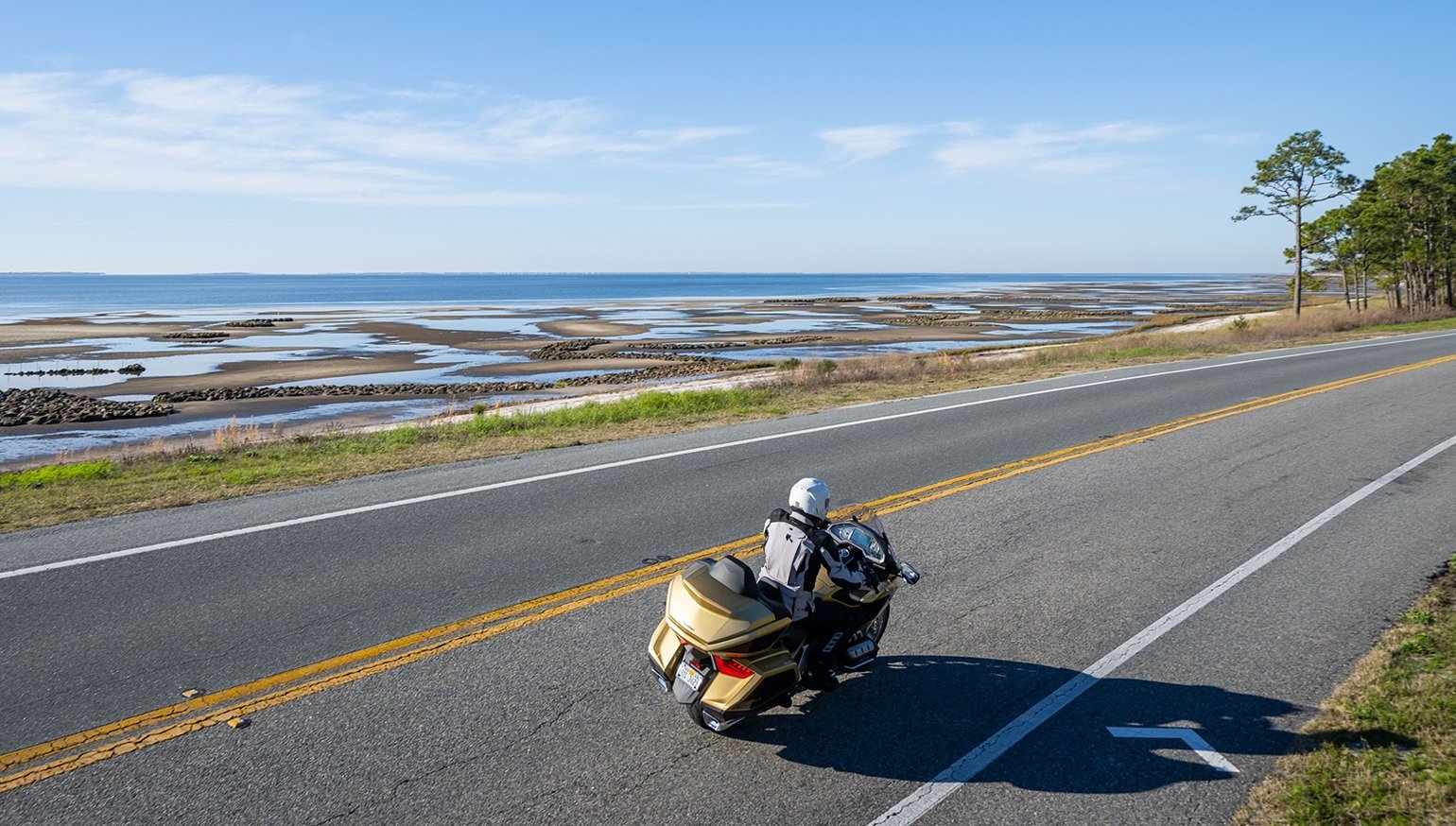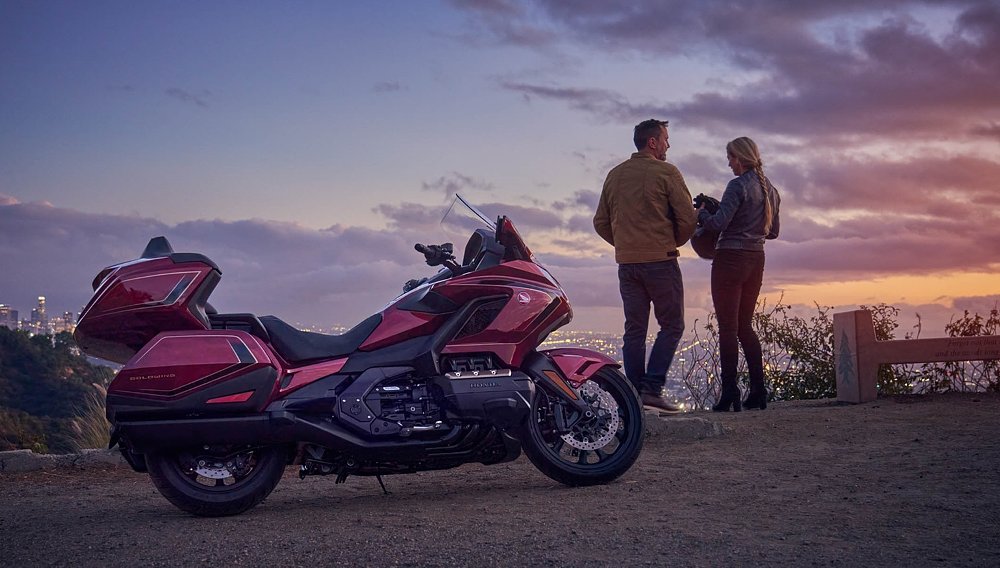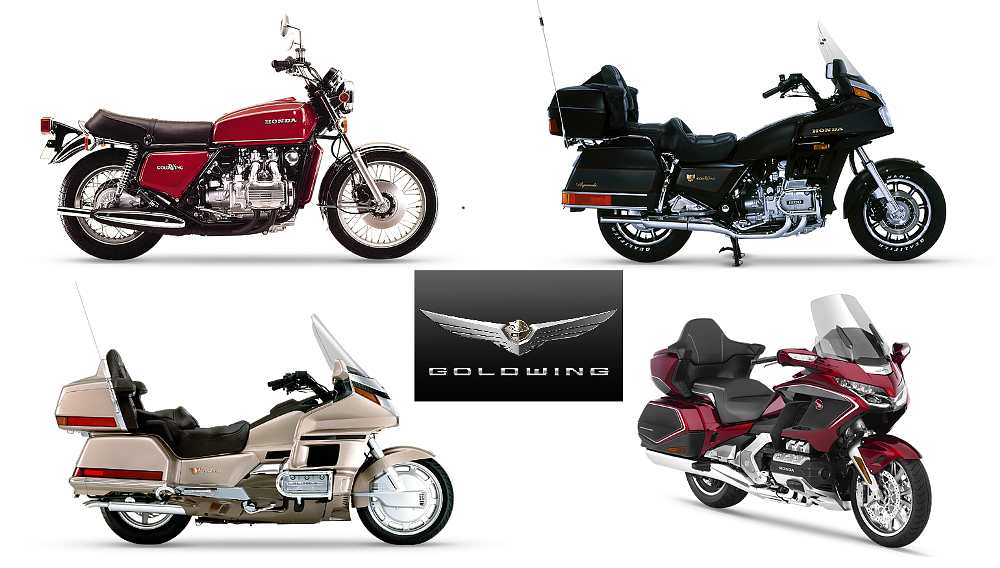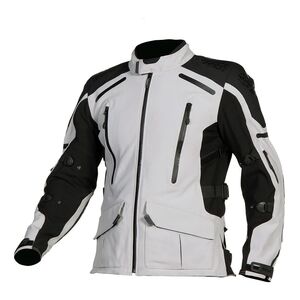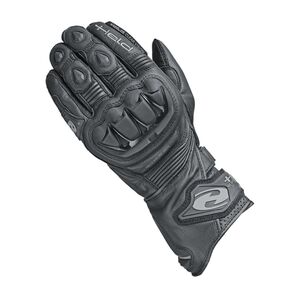I wouldn't say I'd been dreading it, but I had definitely thought about it. And now came the test, maneuvering more than half a ton of 50th Anniversary Honda Gold Wing, rider (that'd be me), and luggage through a tight U-turn on a scrap of pavement and red clay shoulder off a rural two-lane in Alabama.
When manufacturers put together rides for the motorcycle media to introduce a new model, one inevitable feature is the U-turn. That's because we stop at some point with a suitably scenic background and make a few passes back and forth for the photographer. Each of those passes typically has a U-turn at each end. Nobody, including me, wants to look like a duck-walking noob, even if we are on large and unfamiliar bikes, and even less did I want to test the rubber bumpers Honda put on the sides of the flat-six engine to soften the fall if the big Wing leans beyond the point of no return.
Usually, for a low-speed maneuver such as this, I'd use the clutch to modulate the power, rather than relying on fine throttle control alone. But here's the thing. This was my first in-depth exposure to Honda's Dual Clutch Transmission (DCT). The left handgrip on my Bordeaux Red Metallic 50th Anniversary Gold Wing was adorned with many buttons, but no lever. I'd been thinking about this particular maneuver since I'd reserved my spot on the ride.
Spoiler alert: The DCT handled it not just OK, but excellently. I'll have a lot more to say about the DCT later, but first, given how rare it is for a motorcycle model to last in the market for half a century, it's worthwhile to set the scene and talk about, as Honda puts it, "50 years of flight." Let's Wing it.
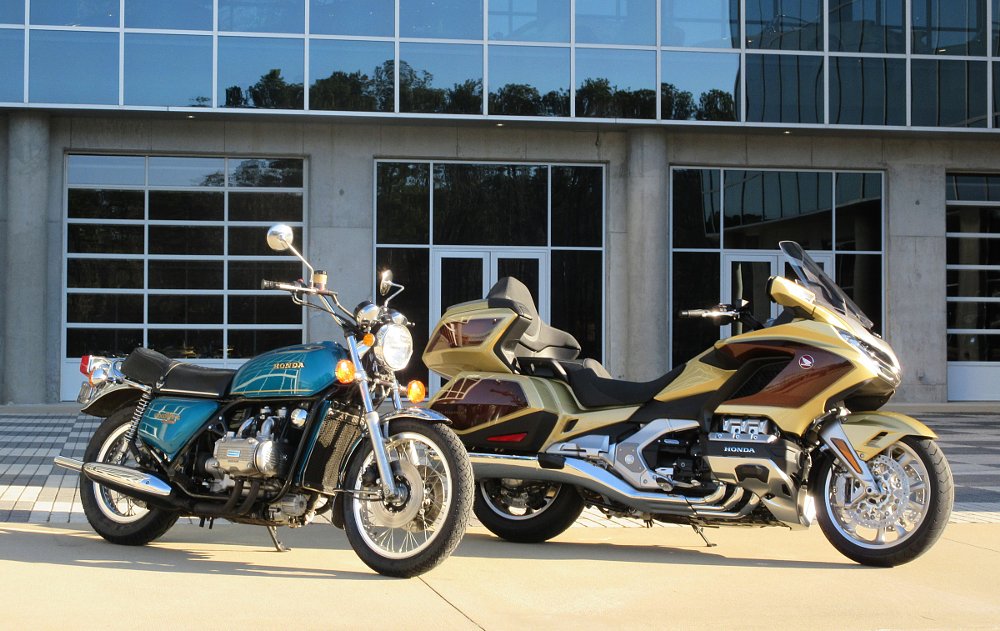
A detour through history
What's the owner of a new 2025 50th Anniversary Gold Wing likely to do with their new motorcycle? They'll probably take some trips, which will likely involve everything from highway miles to scenic back roads. Maybe visit a destination, like the Barber Vintage Motorsports Museum or The Quail Motorcycle Gathering, or join other riders at a rally, like Americade or Daytona Bike Week. Most will probably travel with a passenger, because passenger accommodations have long been a major focus of the Gold Wing. Honda laid out just such a trip for us, a two-day ride from Barber to Daytona — just minus the passengers. And along the way we picked up key pieces of 50 years of history.
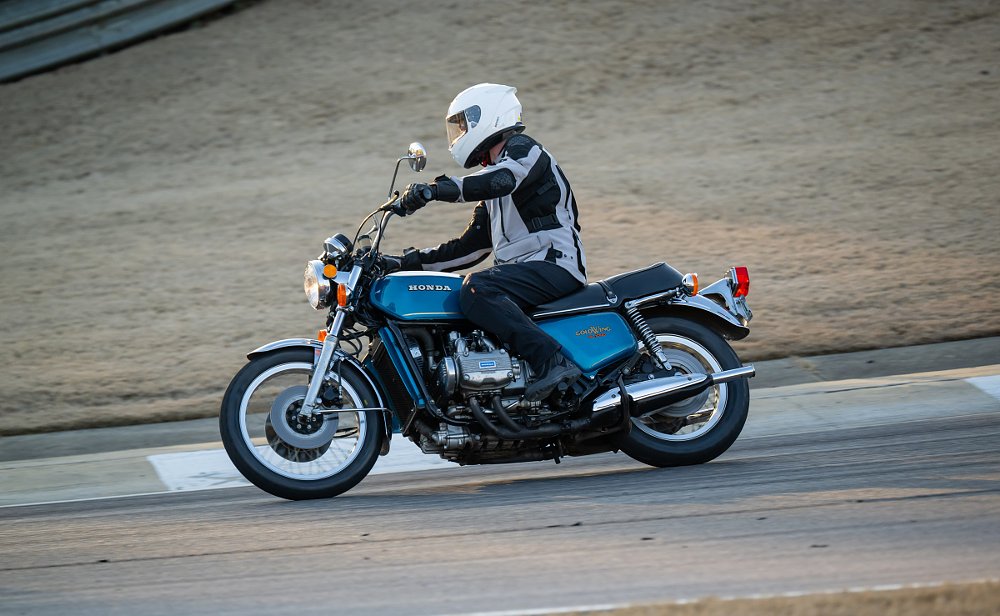
Last year, on the 50th anniversary of the first public appearance of the Gold Wing, we ran through the history of the model by talking to owners of each of the six generations. On this trip, naturally there's one of those original 1975 Gold Wings on display at the Barber Museum, but Honda had also put together a complete collection of models to display under its big tent in the parking lot of Daytona International Speedway during Bike Week.
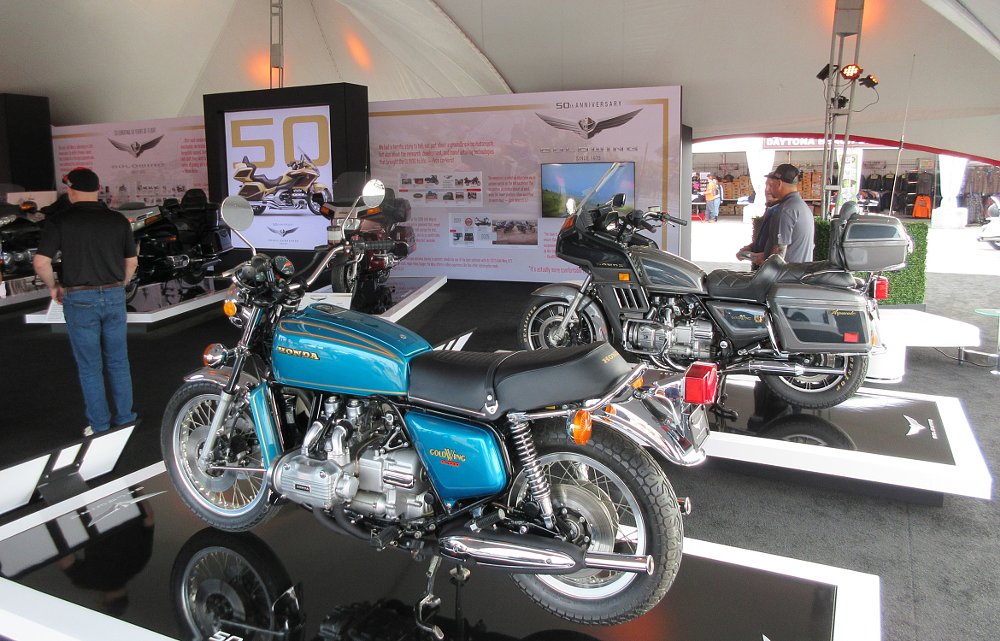
Everyone who buys a 50th Anniversary Gold Wing gets a little model that compares the 1975 to the 2025 versions, and also a book that charts the course of Gold Wing history. Former Cycle World Editor Matthew Miles, who edited the book, and Lee Edmunds, who worked for three decades at American Honda and was involved with multiple Gold Wing generations, were on hand to provide an overview of that history.
"This is the most important model Honda has ever introduced," Edmunds said, pointing to the 1975 model on display. And while I might personally question that, given the more than 100 million Super Cubs Honda has sold worldwide over the decades, if you look at the motorcycle market from a U.S. perspective, his assertion is far more solid. From its beginnings in 1975, the Gold Wing was a model aimed at the U.S. market, intended to build on the performance momentum of the 1969 CB750 and be the "king of kings" (MSRP: $2,899). With its smooth, liquid-cooled flat-four engine and shaft drive, the original GL1000 was made to handle the open spaces and longer distances of North America, though in keeping with standard practice of 50 years ago, a fairing was an option, developed for Honda by Craig Vetter, who invented the popular Windjammer aftermarket fairing in the 1970s. It wasn't until the second generation that the Gold Wing came standard with a fairing, windscreen, and luggage.
Another reason the Gold Wing is particularly significant to the U.S. market is that it accounts for the majority of Honda's motorcycle production in the United States, which began in 1979 at the complex of facilities near Marysville, Ohio. Gold Wings were assembled in the Ohio plant from 1980 to 2009. One of the Wings on display at the Honda tent at Daytona was the one millionth vehicle produced at the U.S. plants.
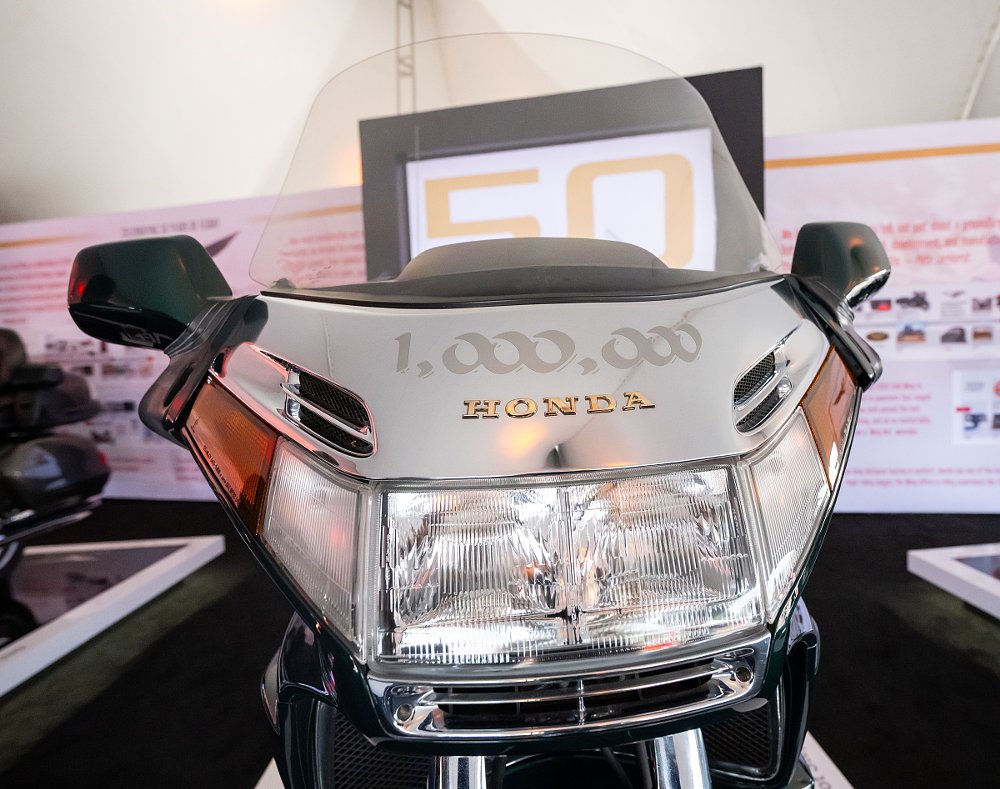
And then there's another unique fact about the Gold Wing that most outsiders wouldn't know but that makes it a real milestone for Honda. The Gold Wing was developed just as company founder Soichiro Honda stepped down from actively managing the company. New President Kiyoshi Kawashima realized Honda was too big to be guided any more by the vision of one leader, so he implemented the "large project leader" approach to developing new products, which the company still uses today for its motorcycles, cars, and other products. The large project leader was the individual responsible for taking input from all the teams involved in developing a new product, from engineers to stylists to testers and production managers, and charting a course. The GL1000 was the first Honda to have a large project leader, Hisaho Nizue.
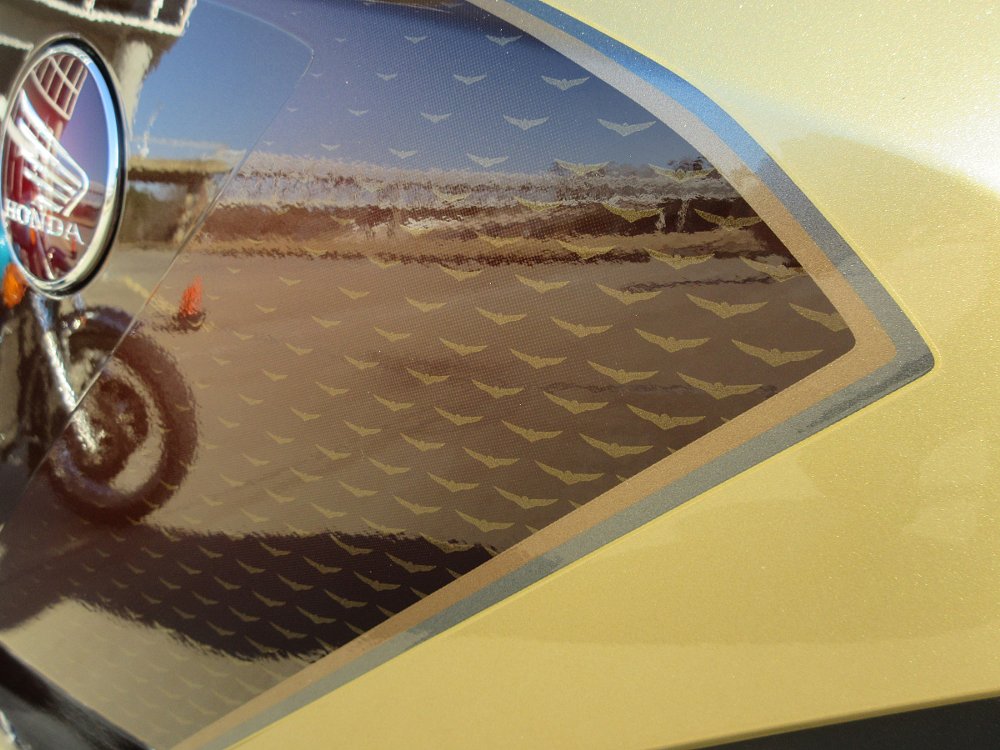
Through the 1980s and 1990s, each generation of Gold Wing grew bigger and more luxurious. The GL1000 became the GL1100 and then GL1200, and then in 1988, Honda issued the six-cylinder GL1500. In the 1990s, the GL1500 reached peak focus on luxury touring. The full bodywork didn't allow even a glimpse of the frame. Since then, the pendulum has swung the other direction.
When Honda introduced the fifth-generation Gold Wing, the GL1800, in 2001, you could see the twin-spar aluminum frame, looking a little like a beefier version of a frame on one of Honda's sport bikes. The intent was to give the Gold Wing some better dance moves to go with its established reputation for reliability and comfort. With the sixth-generation Wing in 2018, Honda took that a step further, cutting about 80 pounds of weight and making the silhouette sharper, more compact.
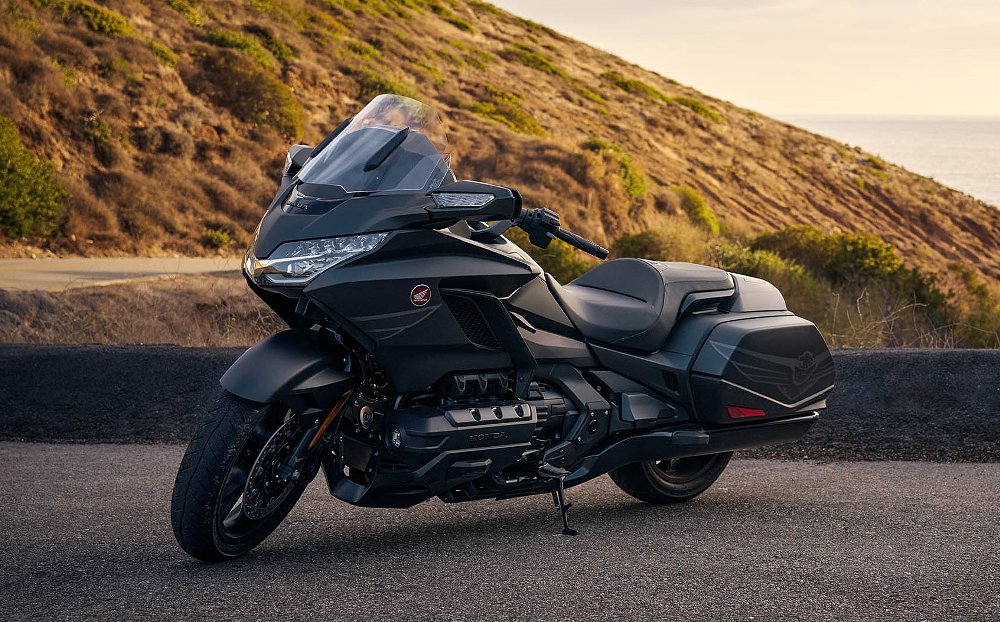
With the current Gold Wing, Honda was trying to expand the appeal, to reach those middle-aged or younger riders who were more familiar with the stereotypes than the motorcycle itself and were likely to say, "I'm not ready for a Gold Wing." Some of those changes, such as the slimmer luggage, met with pushback from the faithful, and Honda even had to reverse course and make the top box larger so that two helmets would fit inside. But there's no doubt the current Gold Wing is in that arc that's curving toward more performance and away from an all-out focus on luxury. Look at the 50th anniversary base model (no top box) with its black paint and ghosted logo on the saddlebags and it's easy to see not so much a luxury tourer as a performance bagger of the type so preferred by riders well short of retirement age.
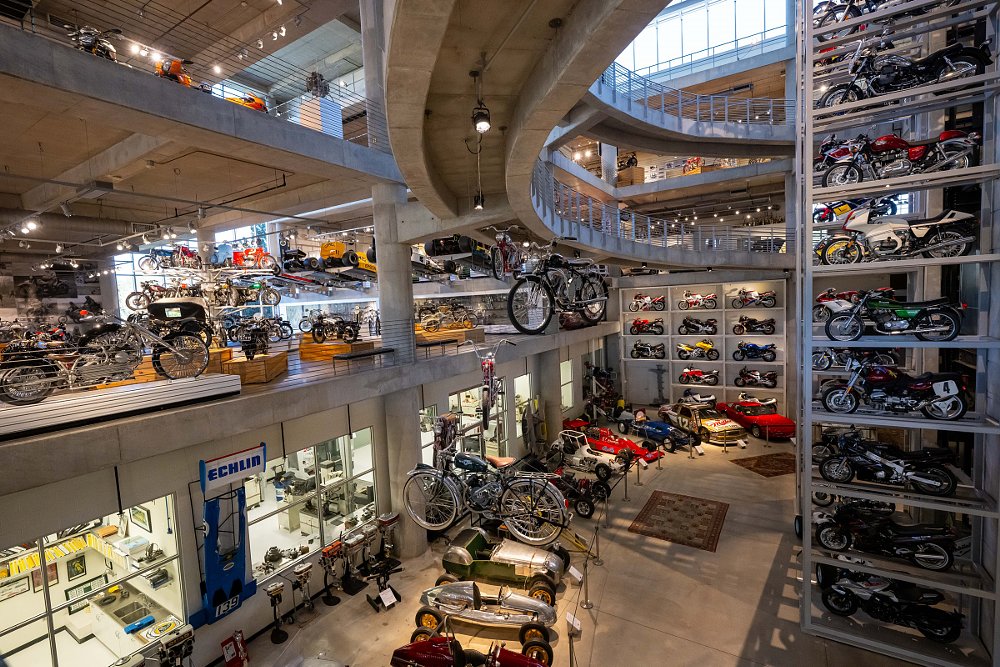
And that brings us to our two-day ride to Bike Week on the 50th Anniversary models. Honda had a few variations available, but I knew exactly which fact-finding mission I wanted to focus on, so I made sure I was in the parking lot early to lay claim to a Bordeaux Red Metallic Gold Wing Tour DCT.
Riding the 50th Anniversary Gold Wing Tour DCT
As I explained in our first look article, you can get a 2025 Gold Wing in the Light Silver Metallic paint scheme that isn't a 50th anniversary model. What separates the 50th Anniversary editions? Really just badging and special colors: the Bordeaux Red Metallic I mentioned above, the unique Eternal Gold color scheme that hearkens back to the landmark 1988 GL1500, and the Matte Black Metallic (I used to think "matte" and "metallic" were contradictory) on the base Gold Wing without the top box.
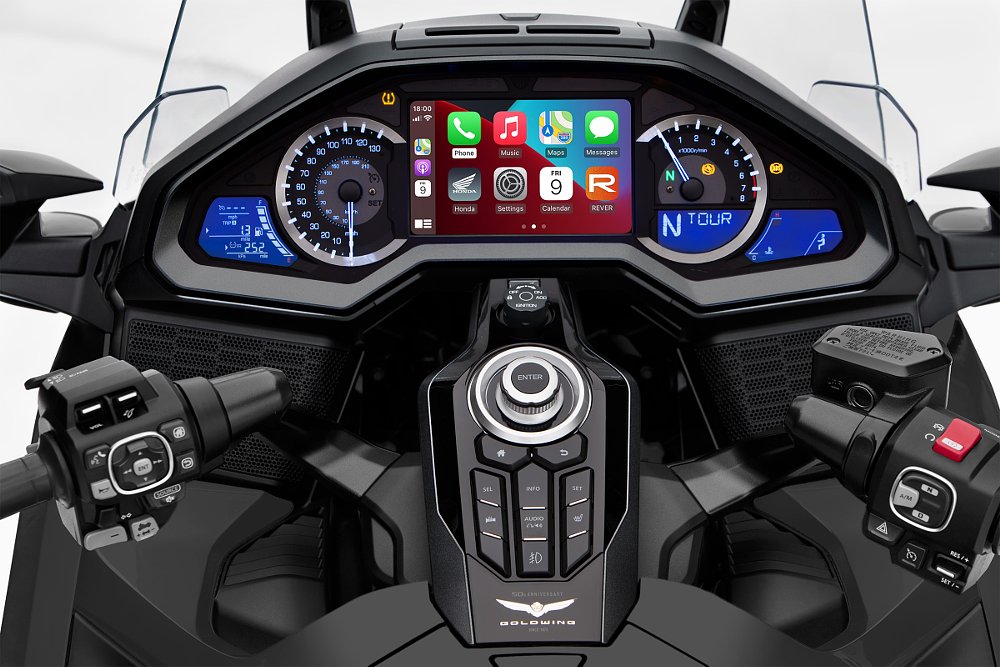
Updates to the Gold Wing since that 2018 model-year overhaul amount to tweaks, mostly. Now that just about every aspect of our lives gets funneled through our smartphones, there's no need for native navigation, so Honda instead focused on making the Apple CarPlay and Android Auto experience more seamless. They say the phone-motorcycle interface is improved, but all I can say is that it works well now, since I hadn't previously tested the current-generation Gold Wing.
What I really wanted to experience — and the reason I was in the parking lot early — was the fully automatic seven-speed DCT transmission. I'd never had a chance to really get to know it thoroughly, and a two-day ride on all kinds of roads seemed like the perfect opportunity. It's not new to the Gold Wing, but it's basically new to me.
Settling into the 50th Anniversary Wing, the sub-30-inch-high seat is as accommodating as you'd expect, but despite its width I was easily able to get both feet flat on the ground, with my 32-inch inseam. The riding position was neutral, the process of pairing my phone was quick and painless, and it only took a few pointers for me to adjust the preload on the rear suspension. That one suspension adjustment can be done electronically, on the Gold Wing's digital display, by choosing settings for a solo rider, rider with luggage, and rider plus passenger with luggage.
There are four ride modes: Sport, Tour, Econ, and Rain. They adjust the shift points on the DCT, as well as throttle response.
Despite my unfamiliarity with the DCT, a 30-second tutorial from the Honda guys was all I needed. Switch from neutral to drive and it's twist-and-go simple. You can let the DCT choose the gear for you or you can put it in manual mode and shift gears using the two switches on the lefthand control pod. Even if you're not in manual mode, you can still override the DCT's choice of gear and downshift or upshift using the swtiches. Then, after a while, the DCT will take over gear-selection chores again.
Leaving Birmingham on city streets, we were soon on a highway, followed by day-long mix of mostly two-lane and a little Interstate highway. Before long, I just stopped thinking about the DCT at all. In Sport mode on the two-lane stretches, I found the DCT would shift pretty much when I would, if I were choosing myself. Tour mode made the transmission upshift a little sooner, and gave the Wing an overall more relaxed feel. I found myself using Tour mode most often, especially as we were trundling through small towns in Alabama and the Florida panhandle. The throttle response felt just a shade smoother. But since you can switch modes on the fly, it was easy to revert to Sport if we hit a section where I wanted to up the pace. Just flick the switch on the righthand pod, the mode message on the digital display flashes, close the throttle a second, and the new mode is selected and it stops flashing. It's a two-second procedure, if you're slow at it, as I am.
After lots of time with Sport and Tour, I decided to try Econ. I switched modes as we sat at a red light at an intersection of two four-lane streets. I accelerated away and by the time I got through the intersection, I looked at the dash and the motorcycle had already shifted into fifth gear. By the time I was going 45 mph, it was in seventh. I'm not sure I'd ever feel the need to use Econ mode.
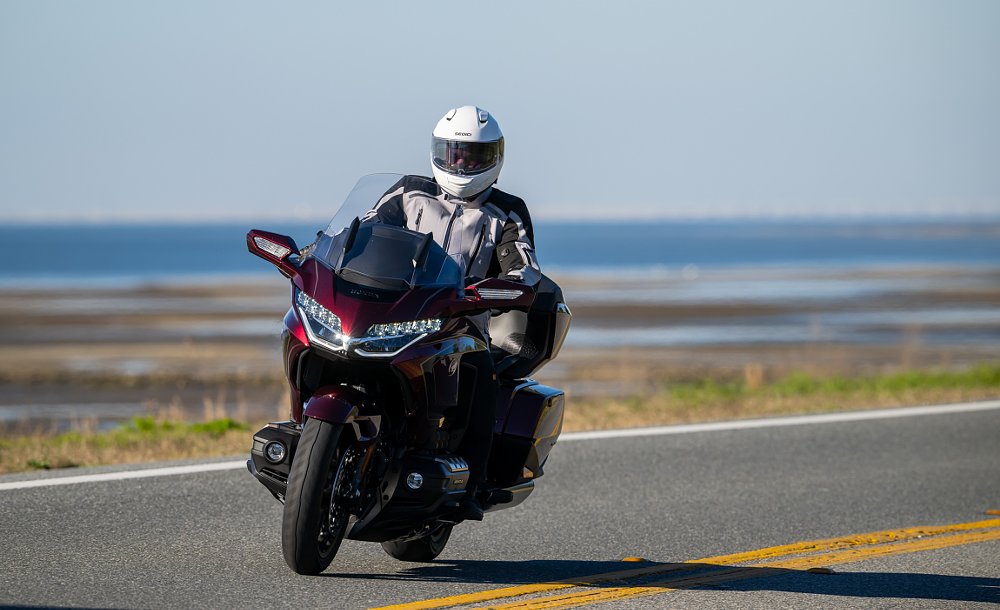
In two days and more than 600 miles of varied riding, there were just two times when I seemed to encounter a glitch with the DCT. Once, accelerating hard on an on-ramp to the Interstate, the transmission hung up in third gear, the engine at redline but the DCT refusing to upshift, so I was no longer gaining speed. I simply flicked the override upshift switch, the bike smoothly went to fourth gear, and then the DCT took over again, normal service resumed. Another time, it seemed to hang in fourth. (Or maybe I just got impatient?) Again, I just flicked an upshift and the issue was gone.
Really, I considered riding in manual mode and doing all my own shifting, but DCT was doing such a good job of it 99% of the time, I really couldn't come up with any reason to bother. And then it was time for some U-turns.
Would this be the DCT's downfall? As it turned out, no. Especially in Tour mode, the throttle response is so smooth I had no problem making slow-speed maneuvers without the usual technique of modulating power with the clutch. The same was true for coming to a stop at intersections and traffic signals in small Alabama towns. It felt awkward to me, not having a clutch to control power as I eased to a stop. Well, it felt awkward for about five minutes. Then I was used to it because the DCT handled that scenario perfectly, as well. Slow-speed maneuvers are further aided because that seventh gear in the DCT is not a higher overdrive gear at the top, but rather an additional gear down low, so the spacing between the gears is narrower. That, along with the abundant torque of the 1,833 cc engine, makes it easier for the DCT to be in an appropriate gear and keep everything moving smoothly, even if you're just inching along in traffic.
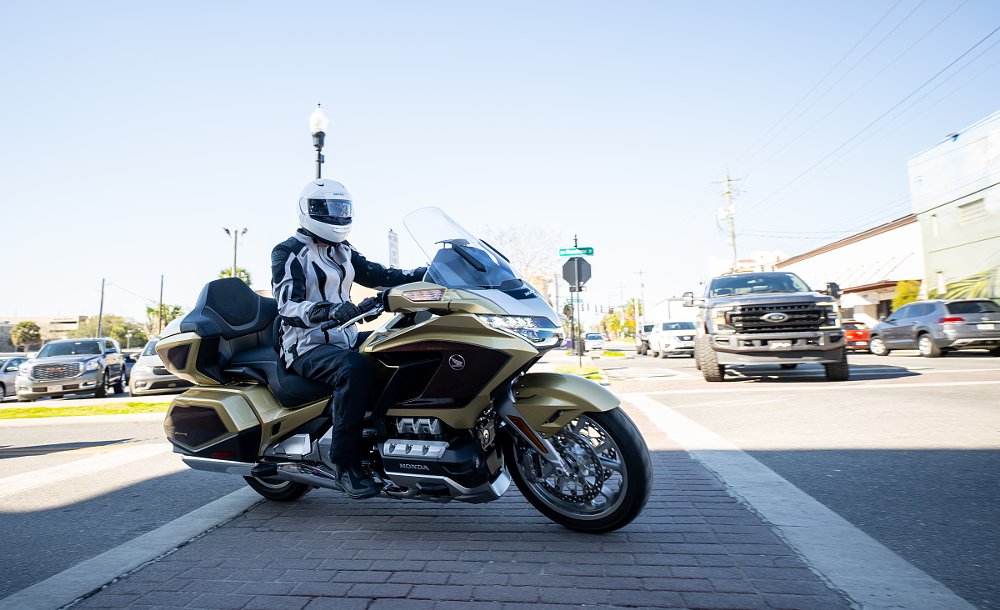
Honda says about 70% of current Gold Wing buyers choose the DCT option, which adds $1,000 to the price, and I can totally understand why. It just works. And for the type of riding most Gold Wingers will do, it works appropriately. More than a few have commented that they have fewer of those "turtle kisses" of rider and passenger helmets bumping when shifting gears, because the DCT does it so smoothly.
Meanwhile, that flat six is still churning out power with locomotive steadiness. Seventh gear at about 2,500 rpm yields an indicated 70 mph, with no vibration, just smooth thrust. It even sounds good, to my tastes. Pulling away briskly from a stop light behind four other Gold Wings, the sound resembled a swarm of angry and particularly deep-throated bees. And if that sounds unappealing to those who want raspy, back-spitting, throttle-blipping "character" while waiting for the light to turn green, then we'll just agree you have different tastes than I do. I especially don't want much "character" when I'm a few hundred miles into a long day of riding.
(Side note: If you have a throttle-blipping habit, you'll want to cure it before riding a DCT-equipped bike or you'll find your front wheel wedged into a dent in the bumper of the car in front of you at the stop light.)
Matching that smooth swell of power are the Gold Wing's competent suspension and brakes. The 2018 redesign introduced a new double wishbone front suspension, replacing the traditional fork, that provides anti-dive properties. The best thing I can say about the suspension and brakes is that I hardly thought about them as both did their jobs predictably and competently. The ride felt reassuringly taut but never harsh or uncomfortable. The linked brakes meant I could use just the front lever for normal usage and get a combination of front and rear braking that, as promised, produced no sensation of front dive.
While I never had the chance, during our group ride, to push the Gold Wing to an ill-advised pace, I get the strong impression that this is a motorcycle that provides maximum rewards when you're riding at, say, seven-tenths pace. That's a little higher than the fifth-generation Gold Wing I last rode. As a package, the Wing and I are still topping half a ton with the saddlebags full, so things could get away from you, I'm sure. But ridden assertively — a step short of aggressively — the Wing was rewarding. It feels comfortable, but not numb.
At five feet, 11 inches tall, I found the electrically adjustable windscreen allowed me to look over it at the lowest setting, creating an acceptable amount of wind noise, but at the highest setting I was looking through the shield and sitting in a perfectly still pocket. On the second morning of our ride, facing the hardships of a 59-degree morning (at least 20 degrees warmer than any temperature I saw at home in the month of February), I raised the windscreen to the top position, switched on the heated grips and heated seat and sat snug in my cocoon of comfort. Not even a winter wimp like me needed a jacket liner. When you turn off the bike, it remembers your settings and restores them the next time you start it, with the accommodating courtesy of a butler. The Gold Wing says, "I recall you prefer your buns toasted, sir. Will the usual medium-rare do? Very good sir!"
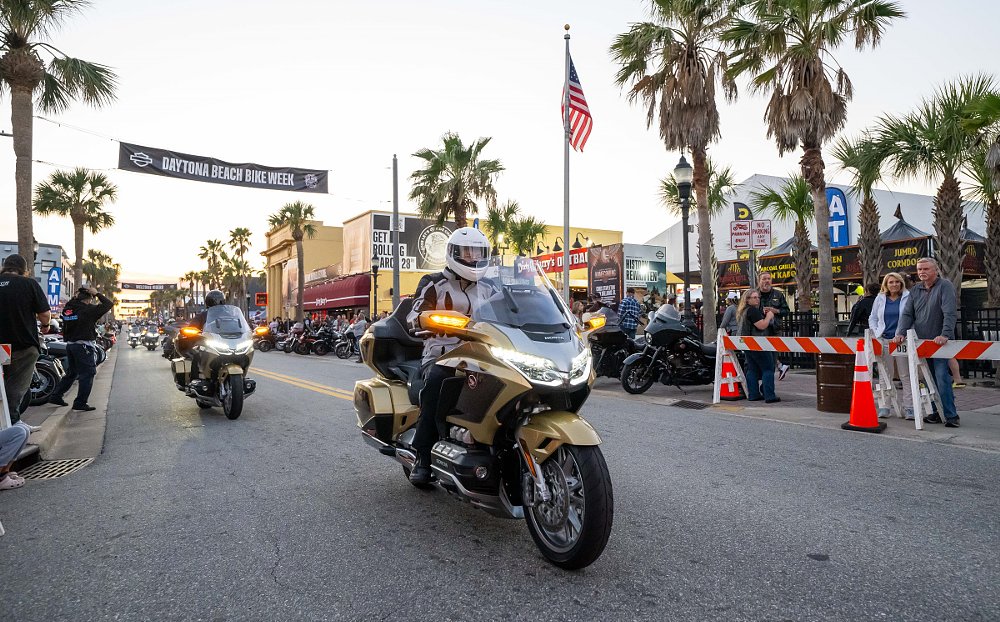
Some additional thoughts on DCT
Humans have many biases, and one of them is normalizing our own experiences. Grow up in one culture and eating salty, fried insects is a treat. In another, it's gross. Both see their way of thinking as perfectly normal.
Since we're motorcyclists, we sometimes have pointless discussions about whether motorcycles with automatics are "dumbed down" or whether riders should be forced to shift gears themselves to build character. I personally don't have time for such discussion. Do you have to use a clutch to be a "real" motorcyclist? What if an old Panhead rider said you weren't a real motorcyclist because you don't know how to retard the spark manually using a lefthand grip? Or if a Norton rider looked down on you for not knowing how to tickle the Amal carbs before kickstarting your bike? Are you not a real motorcyclist if you let mechanical systems retard the spark or turn over the engine for you? What if you let it shift for you?
Only a very misguided person will choose a Gold Wing Tour DCT as a first motorcycle, so it's almost inevitable you'll learn how to shift gears manually on something else, in any case. After that, if you fall among the 70% of Gold Wing buyers who prefer the smooth convenience of the DCT, fine. And if you miss using the clutch and flipping the lever with your toe, as some of the riders in our group did, then fine, as well. I just draw the line at telling others they're doing it wrong if they make a different choice than you do.
We're in no danger of seeing a time in the near future when motorcycles with manual transmissions are hard to find, as has happened in the car world. We have plenty of variations, from twist-and-go scooters to Honda's DCT and E-Clutch, manual transmissions with quickshifters, and the large majority of motorcycles on the market are still equipped with the good old six-speed you learned on. More choices equals better, in my mind, and if you're out there on two wheels, you're a "real motorcyclist" to me, regardless of your choice.
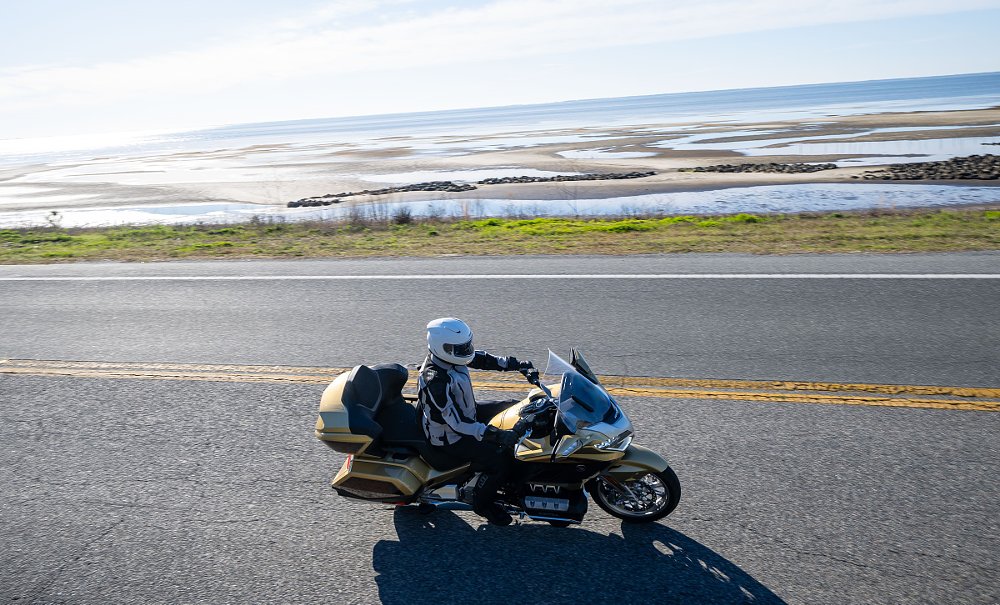
What's next for the Gold Wing?
Though it has a reputation of coming with all the bells and whistles (not that long ago, Gold Wings came standard with not just a stereo, but also a CB radio), that's really not the case any more. While the Gold Wing's cruise control works well, the bike does not have the adaptive cruise control now showing up on similarly top-of-the-line models. And while it's quite handy to be able to adjust rear shock preload electronically, there are quite a few competitors, including ones at lower prices, that now offer electronically adjustable and semi-active suspension.
Does the Gold Wing need those features? Not necessarily, in my view. Will it get them? I wouldn't be surprised. That may be what Honda feels is necessary to keep its flagship true to the vision of the "king of kings" unveiled a half a century ago.
Over the past 50 years, in addition to the homegrown talent at American Honda, the company has sent many of its smart young employees from Japan to the United States to meet the dealers, talk directly to the customers, and learn what the Gold Wing needs to satisfy its biggest market, the United States. A few were on hand, pulling me and other writers aside after dinner, asking questions. At half a century old, I don't believe the Gold Wing is done evolving yet.
| 2025 Honda 50th Anniversary Gold Wing Tour DCT | |
|---|---|
| Price (MSRP) | $30,200 |
| Engine | 1,833 cc, liquid-cooled, 24-valve, horizontally opposed six cylinder |
|
Transmission, final drive |
Seven-speed automatic DCT, shaft |
| Claimed horsepower | NA |
| Claimed torque | NA |
| Frame | Twin spar |
| Front suspension | Double-wishbone system with Showa shock; 4.3 inches of travel |
| Rear suspension | Showa shock; 4.1 inches of travel |
| Front brake | Dual radial-mount Nissin six-piston calipers, 320 mm discs with linked ABS |
| Rear brake | Nissin three-piston caliper, 316 mm disc with linked ABS |
| Wheelbase | 66.9 inches |
| Seat height | 29.3 inches |
| Fuel capacity | 5.5 gallons |
| Tires | 130/70-18 front, 200/55-16 rear |
| Claimed weight | 847 pounds wet |
| Available | Now |
| Warranty | 36 months |
| More info | powersports.honda.com |

 Membership
Membership

